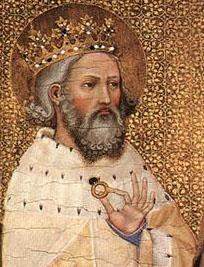Edward the Confessor

The young man who came to be known as Edward the Confessor (who died on this day in 1066 at the age of 62) had no idea that he would ever be the king of England. His father, Ethelred the Unready, had 6 sons by his first wife Elgiva -- which certainly decreased the odds that Edward, one of 2 sons by Ethelred's second wife Emma, would ever be called upon to lead. Things didn't look any better when his father was deposed by the Danes.
When Ethelred died, Edward's mother Emma married the new Danish king of England, Canute. Thus, after a childhood in the cloisters at Ely, Edward was sent to his mother's folks at the court of the duchy of Normandy, where in addition to attaining manhood amid Norman customs, he met and befriended the toddler who would grow up to be William the Conqueror.
When Edward's younger half-brother King Hardicanute (his mother's son by Canute) died in 1042, the nobles in England cast their eyes around the twisted carnage of the Anglo-Saxon and Danish royal lines looking for a successor, and found the unassuming Edward -- the last surviving son of the last Anglo-Saxon king, the stepson of the greatest Danish king, and to boot, a tall and handsome man who certainly looked the part. To guarantee a quick and peaceful succession, Godwin, Earl of Wessex, engineered Edward's coronation at Winchester Cathedral on Easter Sunday, 1043.
At first, the 39-year old king exhibited no particular talent for the job. Though charming, he was not considered to have a very strong personality and was much more interested in spiritual pursuits; so for a time, Edward relied on the powerful presence of Godwin, both for advice and execution. To cement his relationship with Edward, Godwin married his daughter Edith to him, but Edward never consummated the marriage. For all intents and purposes, Edward was married to the Church, and he devoted himself to the building of Westminster Abbey.
Meanwhile, Edward populated his court with Normans, a habit which eventually caused tension between himself and Godwin. In his conflict with Godwin, Edward demonstrated the kind of strategic intelligence that helped him to maintain the throne for more than 20 years; although he would banish Godwin when his needling of the Normans became too heavy-handed, Edward realized this would not be popular with his English subjects, so with his order to remove Godwin from the premises in 1051, he also repealed the danegeld, a tax the Danish kings levied on the English to pay for protection against pirates.
With Godwin in exile, Edward's old friend William of Normandy came to court for a visit, during which time, William would later claim, Edward agreed that he would nominate William as his successor. In 1052, however, Godwin and his sons invaded England, and although Edward was willing to fight, his council of nobles did not want a civil war. Edward was thus forced to pardon Godwin and make Godwin's son, Harold Godwinson, his heir apparent.
In his final years, though he still favored William as his successor, Edward was content to turn over most of his duties to Harold while he tended to the Abbey's progress and occasionally hunted. Edward's ambivalence would ultimately trigger the fight that resulted in one of the most famous battles in history, between Harold and William, after his death -- the Battle of Hastings, and the ensuing Norman Conquest, of 1066.
A week before he succumbed, he had other things on his mind: living to see the consecration of Westminster Abbey, and knowing that he would be buried there. For his devotion to the Church, Pope Alexander III canonized Edward in 1161, and Edward's body was transferred to a new shrine in the then recently rebuilt Abbey.
Labels: Anglo-Saxon England, Kings and Queens





0 Comments:
Post a Comment
Subscribe to Post Comments [Atom]
<< Home